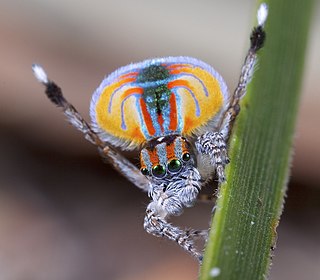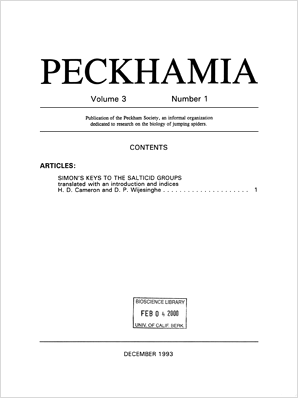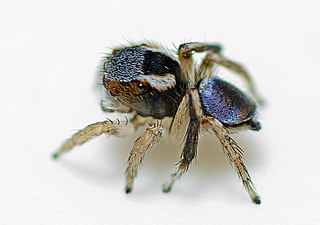
Maratus is a spider genus of the family Salticidae. These spiders are commonly referred to as peacock spiders due to the males' colorful and usually iridescent patterns on the upper surface of the abdomen often enhanced with lateral flaps or bristles, which they display during courtship. Females lack these bright colors, being cryptic in appearance. In at least one species, Maratus vespertilio, the expansion of the flaps also occurs during ritualised contests between males. The male display and courtship dance are complex, involving visual and vibratory signals.

Maratus volans is a species in the jumping spider family (Salticidae), belonging to the genus Maratus. These spiders are native to certain areas in Australia and occupy a wide distribution of habitats. They have a specialized visual system that allows them to see the full visible spectrum as well as in the ultraviolet-range; this helps them detect and pursue prey. Males of this species are characterized by their colourful abdomen flaps that are used to attract females during courtship.

Peckhamia is a peer-reviewed, open-access, scientific journal covering research on jumping spiders. It is published by the Peckham Society, an international organization of naturalists and scientists with an interest in jumping spiders, named in honor of George and Elizabeth Peckham. The journal was established in 1977 and its current editor-in-chief is David E. Hill.

Maratus speciosus, sometimes called the coastal peacock spider, is an Australian species of jumping spider. They are only known to inhabit the vegetation of the coastal sand dunes of southwestern Western Australia. Like other Maratus spiders, the males of the species engage in a courtship display during which they raise their third pair of legs and their abdomen, presenting their colourful opisthosomal plate to potential female partners. Accompanying their elaborate dance moves, males beat their front and back body halves together, sending vibrations that travel through the ground which the females pick up, stimulating them into receiving higher chances of a successful mate. Unlike other Maratus, however, the males of this species have a set of bright orange hairs (setae) along both edges of the opisthosoma which only become visible during this display. Maratus speciosus derives from the arachnid class with both sexes measuring about 5 mm in body length, equivalent to a pencil eraser. They are known as the smallest species of spiders. This organism is known as diurnal cursorial hunters, meaning they feed on insects. Like any other jumping spider, they rely on their keen vision and jumping actions to help them travel and spot prey at far distances.
Maratus jactatus is a species of the genus Maratus, an Australian member of the jumping spider family. Maratus jactatus are from the jumping spider group Salticidae. The name jactatus is Latin for rocking - derived from their signature mating rituals. Maratus jactatus have the ability to jump lengths up to 50 times their size. They have been collected only in Wondul Range National Park in southern Queensland. Sparklemuffins are very small spiders that range from being four to six millimeters in length, similar to the length of a grain of rice. The males are close to four and one half millimeters long, which is smaller compared to the female who are about five and three tenths millimeters long.
Maratus sceletus is a species of the genus Maratus, an Australian member of the jumping spider family. Described in 2015, they have been collected only in Wondul Range National Park in southern Queensland. The species name is derived from the Latin sceletus "skeleton", from its distinctive body pattern. Maratus sceletus is a small species, from 3.7 to 4.7 mm long. The male is black with prominent white stripes and markings across its carapace and legs.

Maratus nigromaculatus is a species of the genus Maratus, an Australian member of the jumping spider family. Described in 1883 by Keyserling as Ergane nigromaculata from a specimen from Rockhampton, they are found in Queensland. The species name is derived from the Latin words niger "black" and maculatus "spotted".

Maratus spicatus is a species of the genus Maratus, an Australian member of the jumping spider family. It was described in 2012 and is native to Western Australia.
Maratus albus is a species of the peacock spider genus, characterised by its distinctive courtship display.
Maratus australis is a species of the peacock spider genus, characterised by its distinctive courtship display.
Maratus bubo is a species of the peacock spider genus, characterised by its distinctive courtship display.
Maratus lobatus is a species of the peacock spider genus, characterised by its distinctive courtship display. They are found on the south coast of Western Australia and in South Australia.
Maratus tessellatus is a species of the peacock spider genus, characterised by its distinctive courtship display.
Maratus vespa is a species of the peacock spider genus, Maratus, characterised by its distinctive courtship display. The male spiders are characterized by a bright abdomen, lateral flaps, and an elongated third pair of legs. When attempting to attract a mate, the male spider will raise its colourful abdomen and elongated third pair of legs and wave them, along with extending its lateral flaps. This complex display of courtship is analogous to that of a peacock, hence the common name of this spider species.
Maratus vultus is a species of the peacock spider genus, characterised by its distinctive courtship display.
Maratus harrisi is a species of the genus Maratus, an Australian member of the jumping spider family. It was described in 2011 and is native to the Australian Capital Territory.
Maratus combustus is a species of peacock spider native to Australia. The species was discovered together with Maratus felinus and Maratus aquilus by a research group from Monash University, near Lake Jasper in the South West region of Western Australia. However, the ranges of each species do not overlap.

Maratus mungaich, the banksia peacock spider, is a species of jumping spider in the family Salticidae. It is endemic to Western Australia.

Saitis mutans is a species of spider in the genus Saitis. It is endemic to Australia.

Maratus anomalus or the unusual peacock spider, is a species of peacock spider in the family Salticidae. M. anomalus was described by Karsch in 1878 in Queensland Australia and New South Wales.









